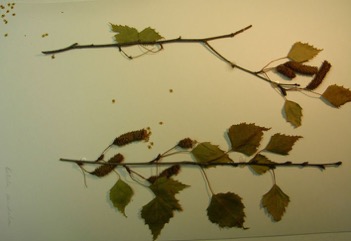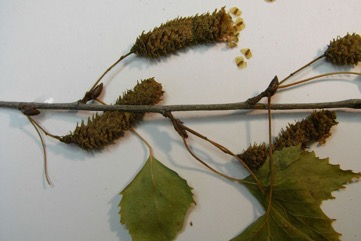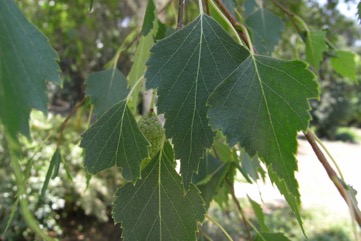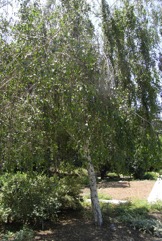European Birch, Silver Birch

It is a temperate plant. It is native to North Asia and Europe. It grows in temperate broad-leaved forests between 500–2300 m altitude in China. It can grow in many soil types. It is very hardy. It needs to be in full sun. It does best in sandy soils with a pH below 6.5. It does poorly in alkaline soils. It suits hardiness zones 2-9. Tasmania Herbarium. Arboretum Tasmania.
Also known as:
Breza, Briza belokora, Chui zhi hua, European white birch, Jajaknamu, Lady of the woods, Majfa, Navadna breza, Nyir, Nyirfa, Weeping birch
Synonyms
- Betula verrucosa Ehrhart.
- Betula alba
Edible Portion
- Flowers, Leaves, Sap - wine, Bark
Where does European Birch grow?
Found in: Argentina, Asia, Australia, Balkans, Belarus, Bosnia, Britain, Canada, Caucasus, Central Asia, China, Czech Republic, Denmark, Estonia, Europe, France, Georgia, Germany, Greece, Hungary, Iraq, Kazakhstan, Korea, Latvia, Lithuania, Luxembourg, Macedonia, Mongolia, North America, Norway, Poland, Romania, Russia, Scandinavia, Serbia, Siberia, Slovakia, Slovenia, South America, Spain, Sweden, Tasmania, Turkey, Ukraine, United States
Notes: There are about 60 Betula species. They grow in cool north temperate climates.
Status: The sap is drunk or frozen by children.
Growing European Birch, Silver Birch
Cultivation: Plants are grown from seed. Seed germinate easily.
Edible Uses: The sap has a sweet flavour and is eaten. Wine is made from the sap. The sap can also be made into vinegar. The young leaves can be eaten fresh in salads or lightly cooked as a vegetable. The inner bark is powdered and cooked and eaten. The flower spikes are milled into flower and added to bread.
Production: It is fast growing. Trees can yield 82 litres per tree during a week in early spring.
Nutrition Info
per 100g edible portion| Edible Part | Energy (kcal) | Protein (g) | Iron (mg) | Vitamin A (ug) | Vitamin c (mg) | Zinc (mg) | % Water |
|---|---|---|---|---|---|---|---|
| Flowers | - | - | - | - | - | - | |
| Leaves | - | - | - | - | - | - | |
| Sap | - | - | - | - | - | - | |
| Bark | - | - | - | - | - | - |
European Birch, Silver Birch Photos




References
Beckstrom-Sternberg, Stephen M., and James A. Duke. "The Foodplant Database." http://probe.nalusda.gov:8300/cgi-bin/browse/foodplantdb.(ACEDB version 4.0 - data version July 1994) (As Betula alba)
Bodkin, F., 1991, Encyclopedia Botanica. Cornstalk publishing, p 144 (Also as Betula alba)
Bremness, L., 1994, Herbs. Collins Eyewitness Handbooks. Harper Collins. p 39
Brown, D., 2002, The Royal Horticultural Society encyclopedia of Herbs and their uses. DK Books. p 142
Bussman, R. W., et al, 2016, A comparative ethnobotany of Khevsureti, Samtskhe-Javakheti, Tusheti, Svaneti, and Racha-Lechkhumi, Republic of Georgia (Sakartvelo), Caucasus. Journal of Ethnobiology and Ethnomedicine (2016) 12:4
Cerne, M., 1992, Wild Plants from Slovenia used as Vegetables. Acta Horticulturae 318.
Coombes, A.J., 2000, Trees. Dorling Kindersley Handbooks. p 123
Cundall, P., (ed.), 2004, Gardening Australia: flora: the gardener's bible. ABC Books. p 236
Denes, A., et al, 2012, Wild plants used for food by Hungarian ethnic groups living in the Carpathian Basin. Acta Societatis Botanicorum Poloniae 81 (4): 381-396
Duke, J.A., 1992, Handbook of Edible Weeds. CRC Press. p 48 (As Betula alba)
Etherington, K., & Imwold, D., (Eds), 2001, Botanica's Trees & Shrubs. The illustrated A-Z of over 8500 trees and shrubs. Random House, Australia. p 131
Harris, E & J., 1983, Field Guide to the Trees and Shrubs of Britain. Reader's Digest. p 28
Hedrick, U.P., 1919, (Ed.), Sturtevant's edible plants of the world. p 107 (As Betula alba)
Heywood, V.H., Brummitt, R.K., Culham, A., and Seberg, O. 2007, Flowering Plant Families of the World. Royal Botanical Gardens, Kew. p 61
Hibbert, M., 2002, The Aussie Plant Finder 2002, Florilegium. p 43 (As Betula alba)
Irving, M., 2009, The Forager Handbook, A Guide to the Edible Plants of Britain. Ebury Press p 62
Janaćković, P. et al, 2019, Traditional knowledge on plant use from Negotin Krajina (Eastern Serbia): An ethnobotanical study. Indian Journal of Traditional Knowledge Vol 18 (1), pp 25-33
Joyce, D., 1998, The Garden Plant Selector. Ryland, Peters and Small. p 107
Kim, H. & Song, M., 2013, Ethnobotanical analysis for traditional knowledge of wild edible plants in North Jeolla Province (Korea). Genetic. Resour. Crop Evol. (2013) 60:1571-1585
Li Peiqiong; Alexei K. Skvortsov, BETULACEAE, Flora of China
Little, E.L., 1980, National Audubon Society Field Guide to North American Trees. Alfred A. Knopf. p 369
Lord, E.E., & Willis, J.H., 1999, Shrubs and Trees for Australian gardens. Lothian. p 48
Luczaj, L., 2012, Ethnobotanical review of wild edible plants of Slovakia. Acta Societatis Botanicorum Poloniae 81(4):245-255
Luczaj, L., et al, 2015, Wild food plants and fungi used by Ukrainians in the western part of the Maramureş region in Romania. Acta Soc Bot Pol 84(3):339–346
Lyle, S., 2006, Discovering fruit and nuts. Land Links. p 93
Pieroni, A. & Soukand, R., 2017, Are Borders more Important than Geographical Distance? The Wild Food Ethnobotany of the Boykos and its Overlap with that of the Bukovinian Hutsuls in Western Ukraine. Journal of Ethnobiology 37(2): 326–345
Plants for a Future database, The Field, Penpol, Lostwithiel, Cornwall, PL22 0NG, UK. http://www.scs.leeds.ac.uk/pfaf/
Postman, J. D., et al, 2012, Recent NPGS Coordinated Expeditions in the Trans-Caucasus Region to Collect Wild Relatives of Temperate Fruit and Nut Crops. In Acta Horticulturae Number 948 p 191-198
Redzic, S. J., 2006, Wild Edible Plants and their Traditional Use in the Human Nutrition in Bosnia-Herzegovina. Ecology of Food and Nutrition, 45:189-232
Sfikas, G., 1984, Trees and shrubs of Greece. Efstathiadis Group. Athens. p 132
Shikov, A. N. et al, 2017, Traditional and Current Food Use of Wild Plants Listed in the Russian Pharmacopoeia. Frontiers in Pharmacology. Vol. 8 Article 841
Simkova, K. et al, 2014, Ethnobotanical review of wild edible plants used in the Czech Republic. Journal of Applied Botany and Food Quality 88, 49-67
Slocum, P.D. & Robinson, P., 1999, Water Gardening. Water Lilies and Lotuses. Timber Press. p 112
Soukand, R., et al, 2017, Multi-functionality of the few: current and past uses of wild plants for food and healing in Liubań region, Belarus. Journal of Ethnobiology and Ethnomedicine (2017) 13:10
Tent. fl. Germ. 1:405. 1788
Urgamal, M., Oyuntsetseg, B., Nyambayar, D. & Dulamsuren, Ch. 2014. Conspectus of the vascular plants of Mongolia. (Editors: Sanchir, Ch. & Jamsran, Ts.). Ulaanbaatar, Mongolia. “Admon“ Press. 334pp. (p. 143-158).
World Checklist of Useful Plant Species 2020. Royal Botanic Gardens, Kew
www.eFloras.org Flora of China
Young, J., (Ed.), 2001, Botanica's Pocket Trees and Shrubs. Random House. p 139